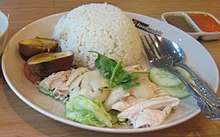Hainan people
The Hainan people (Chinese: 海南人), also known as Hainanese or Hainam nang (in Hainanese dialect), are the native people (including Han Chinese) who originate from Hainan, the southernmost and smallest Chinese province. The term "Hainanese" was frequently used by all inhabitants of Hainan island to refer to themselves overseas. Min speaking Hainanese often refer to themselves as Qiongwen to distinguish themselves from other ethnic groups of Hainan such as the Cantonese or Tanka.
| Total population | |
|---|---|
| 5 million+ worldwide | |
| Regions with significant populations | |
| Hainan, Southeast Asia (Vietnam, Cambodia, Thailand, Singapore, Malaysia and Indonesia), Oceania, Americas | |
| Languages | |
| Hainanese, Mandarin other minority languages: Hlai languages, Kim Mun, Tsat, Danzhou dialect and various other languages of the counties that they inhabit | |
| Religion | |
| Atheism, Confucianism, Taoism, Christianity, Buddhism |
History
_(14784285493).jpg)
Most Hainanese Han people were originally fishers[1] from the Chinese provinces of Guangdong[2] and Guangxi who later settled in the island of Hainan, while the Lingaoese, Tanka and Li natives invaded the island earlier and were descendants of the Yue tribe, from mainland China.[3]
During the fall of the Song Dynasty, Min Hainanese-speaking colonists of scholars and military families arrived and colonized the island from the three districts of Xinghua prefecture (including Putian city) in the centre-coast of Fujian province pushing many if not most of the local inhabitants to the impoverished areas. As a result of the assimilation of other dialect groups, many Hainanese genetically cluster with Han Chinese from Guangdong and Guangxi instead of Fujianese people.[4]
Similarly to Fujian and Guangdong provinces, Hainan has been a source for immigrants. Towards the turn of the 20th century, many Hainanese migrated to various Southeast Asian nations, where they worked as cooks, restaurateurs, coffee shop owners, clothesmakers, sailors and hoteliers. Chan Sing, one of the "villain" movie stars that dotted the Hong Kong movie industry was of Hainanese ancestry, as was the bartender who invented the world-famous Singapore Sling at the renowned Singapore Raffles Hotel, Mr. Ngiam Tong Boon. In Thailand, singer Nichkhun of 2PM, media mogul Sondhi Limthongkul, the politically influential Sarasin family, as well as two of the wealthiest business families, the Chirathivats and the Yoovidhyas, all trace their ancestries to Hainan. In Laos, former deputy prime minister Somsavat Lengsavad is also of Hainanese descent.
Culture
Language
In Hainan, the local Han Chinese speak Hainanese, a Min Chinese language also known as Qiongwen, as their native tongue. The dialect of Wenchang (文昌) is spoken by Hainanese from the northern parts of Hainan.[5] Numerous Wenchang Hainanese descended from Jinshi and merchants from Putian as many of their Jiapu (family genealogies) show.[6] This is also why they pronounce some words with the Hokkien twang (example: close door is "gieh mui" for other Hainanese dialects. Today, many Wenchang Hainanese still return to Putian for ancestors tomb cleaning (清明). Many Hainanese who have surnames largely found only in Cantonese people like 麦, 邝, 莫, 谭, 岑, 庞, 梅, etc. have ancestry from Cantonese immigrants who immigrated to the island in waves especially during the Ming dynasty as indicated in historical records and their jiapus.[7] Standard Chinese (phonologically based on Beijing Mandarin) is also the lingua franca in the island province as in the rest of China.
Cuisine

The Hainanese are known for their signature dishes such as the Hainanese chicken rice, Wenchang chicken, Hainanese pork chop, Hainanese mutton soup, Hainanese salted fish soup and beef noodle soup.
Notably, in Singapore, these signature dishes are served at the various eateries located along Purvis Street, within the Hainanese enclave; as a result, Purvis Street is often referred to as "Hainan Second Street", while Middle Road and Seah Street are referred to as "Hainan First Street" and "Hainan Third Street" respectively.[8] Hainanese chicken rice is a recognised dish throughout Southeast Asia due to the Hainanese diaspora in these areas who famed it. It is often labelled as Singapore's national dish.[9]
Arts
Hainanese opera (Qiong opera) is a passion for many Hainanese, particularly for the older generation. Enriched with local flavours, Hainanese opera is part and parcel of Hainanese culture.[10]
See also
- Han Chinese
- Min-speaking peoples
- Thai Chinese
- Singaporean Chinese
- Malaysian Chinese
- Indonesian Chinese
- Li people
- Cantonese people
- Yangpu Ancient Salt Field
References
- Tim Doling (1972). The Annals of Philippine Chinese Historical Association, Issues 3-7. Philippine Chinese Historical Association.
- Koen De Ridder (2001). "Weiying Gu". Authentic Chinese Christianity: Preludes to Its Development (nineteenth and Twentieth Centuries). Leuven University Press. ISBN 90-586-7102-X.
- David Goodman (2002). China's Provinces in Reform: Class, Community and Political Culture. Routledge. ISBN 11-347-1270-7.
- "A comprehensive map of genetic variation in the world's largest ethnic group - Han Chinese". bioRxiv 10.1101/162982.
- "Archived copy". Archived from the original on 2011-06-05. Retrieved 2011-04-15.CS1 maint: archived copy as title (link)
- Abigail Ng WY (23 March 2017). "Youth camps keep Hainanese alive". The Straits Times Singapore. Retrieved 2017-05-23.
- Kugiya, Hugo (March 18, 2010). "Singapore's national dish: Hainan chicken rice". Crosscut. Archived from the original on 2011-08-31. Retrieved August 20, 2011.
- Tim Doling (1996). Visiting Arts regional profile: Asia Pacific arts directory. UNESCO Publishing. ISBN 92-310-3254-2.
| Wikimedia Commons has media related to Hainanese people. |